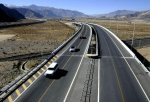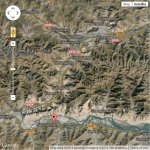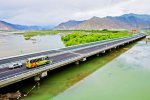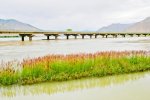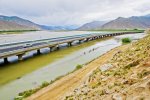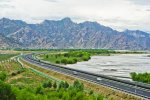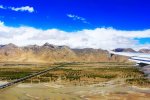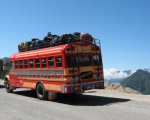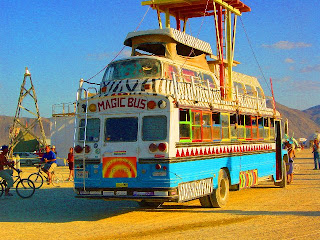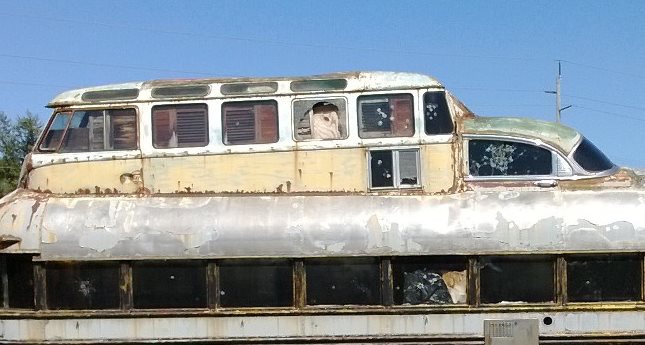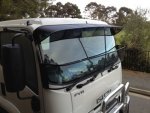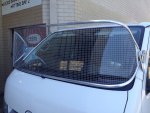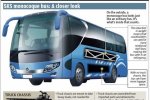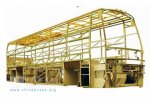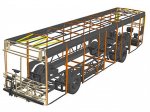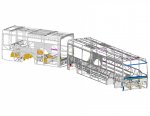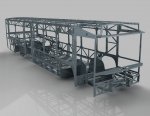Hi
thjakits,
Responses to your points in succession:
...Just do me a favor - don't go to the James Bond submarine-ing vehicles.... - trains is enough off track (...pun intended)!
[Very interesting, especially the China related developments!]
Nope. No submarines will be entertained here. I only posted some stuff about amphibious vehicles because
Amphibeast is so enthusiastic about water......:sombrero:
One question:
Are you going to actually start "development" of your Terraliner on here (Expedition Portal) eventually or is this thread strictly to discuss "All and Everything!" ??
......does/will it lead to something/WHAT?
Yes. Will post my designs here, once I am done. In about a year......

Sorry, I have to do it that way.
But did you get a chance to read the compact summary of vehicle specifications, as prompted by
campo? See post #686 at
http://www.expeditionportal.com/for...pedition-RV-w-Rigid-Torsion-Free-Frame/page69 . What do you think?
Absolute rigid frame - by definition of the thread - is a must - ....or is it??
I have no specific example and just a very fuzzy idea in my head, BUT what about a rigid structure, incl. the driver cab - mounted diamond style or triangular style on a "full flex frame" (e.g. Unimog-like, frame DESIGNED to flex)?
You still get your fully integrated driver-cab, but take advantage of the considerably lighter flex-frame construction.
[If your Terraliner is a totally new design (NOT based on a KAT, TATRA or KAMAZ or..??) you might get away with a purpose designed BOX and not have a weight penalty to pay. Other than that - ALL the mentioned chassis are that, chassis - built to carry loads in any and all forms, so rigidity is IN the chassis, not in the "whatever"-structure on top.
Maybe you start by designing a Steel-cage/monocoque/exoskeleton BOX and just add the suspension and drive-train components from suppliers (forget about TATRA then...)]
Excellent point. Campo raised the same issue, suggesting that "monocoque" construction might be the way to go. But as you suggest, the stress is then distributed throughout the vehicle, and that may or many not be a good thing. Becauese this means that structural strength must be distributed throughout the vehicle as well, which means (possibly) more weight higher up? In a typical expedition motorhome, because the camper is basically made out of plastic, and is sitting on a very heavy steel chassis that absorbs all the stress, the center of gravity is extremely low. So this becomes possible:
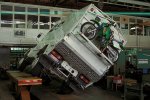
I was also wondering: if MAN or TATRA could have made their frames lighter, wouldn't they have? MAN does make a lighter framed vehicle, the HX series. But MAN does not promise that the HX series chassis will be torsion-free, and that it will not twist. It only promises that the SX series chassis, whose longitudinal stringers are quite a bit visibly thicker, will not twist.
But I am very open to your idea. Any weblinks you might suggest, to help think through a "large monocoque camper" further? I return to college shortly, so I will also ask colleagues what they think.
Not sure if your Art-Deco wishes are any good for a "useful" Terra Cruiser - you may not like straight lines, but they are a an awful lot easier to fix than compound curves - if things break!
Interesting thought. I guess I just assumed that one should drive an expedition motorhome much as one drives a car, trying to avoid collisions that will damage the body.....:coffeedrink: And that once the body is damaged, just like a car, one basically has to drive to an auto-body shop where a specialist does the repairs. If the damage is minor, then one
should drive to such a specialist, even if it means a major detour of 500 km. But if major, then one will not be repairing the damage oneself anyway. Auto body shops the world over are familiar with the compound curves in cars, because most cars do not have bodies made out of square pieces of plastic just glued together. So if auto body shops the world over can handle the compound curves in cars, why shouldn't they be able to handle the compound curves in a motorhome?
You seem to be suggesting that boxy-square expedition campers are deliberately designed in such a way so that overlanders can do lots of minor, amateur, on-the-fly repairs themselves, in the middle of nowhere. I've heard the argument before, but I am not sure if I buy it.
I've also heard another argument: that the main reason why expedition campers tend to be so "boxy" and rectilinear, is because boxy sandwich-ply construction is comparatively cheap. You just take flat sheets, cut them, and glue them together. Whereas mainstream production motorhomes can be more curvilinear, because they are made in production runs where it becomes cost-effective to create curved molds, molds used more than once. Now I am actually thinking of this "Liner" motorhome as more of a production-run type of vehicle, not as a one-off or bespoke design for just one person, as per most UniCat or ActionMobil vehicles. In other words, I am thinking of it as more of a mainstream motorhome that,
unlike a mainstream motorhome, can go anywhere.
[The camper with the huge curved front window - what a nightmare if that one breaks or nicks!! .....not to mention the heat when in the sun - I think there is way too much concentration on the COLD on this thread vs. HEAT - most people will tend to STAY in WARM areas and just visit the cold ones for short periods]
Actually, if you look over at the "Camper Thermal Engineering" thread, you'll see that the window in the Burstner Panorama is
smaller than the more vertical and "standard-looking" window in the Concorde Liner Plus. Because the Burstner is only 3 m high, whereas the Concorde is 3.6 m high. As for fragility, well, I suppose pretty much any window can break. Perhaps what you mean to say is, if the window in the Burstner Panorama breaks, then the front seat of the camper will be open to the sky. Whereas if a more vertical sort of window breaks, then there would still be the roof of the vehicle protecting the driving position from the elements.
As for cold: yes, the thread has concentrated on cold. I went that way because it's my general impression that, like altitude, cold is not sufficiently addressed when thinking through expedition vehicle designs. As you say, most people tend to want to take their rigs to sunny, warm climates at sea level, and so the focus is usually on AC systems and insulating against outside heat, thermal gain, etc. I figured that is pretty much covered in the standard specifications of expedition motorhomes that one finds on the UniCat and ActionMobil websites. Such vehicles are almost always designed to withstand the heat of crossing the Sahara, for instance. But what I really want to know is: can they handle -50 C in Siberia?
On the topic of thermal gain: please see some of the stuff that I will be finishing up in the Camper Thermal Engineering thread shortly, about "smart window" films in particular.
Basic question is, if you want a design statement or a usable, self-sustainable vehicle (self-sustainable for the crew travelling with it) - as mentioned before: You won't have a 800-number to call road-service, nor a support crew to get the spare of the roof [not my choice to store a HEAVY load) and mounted or to fix a blown tire.
Much earlier in the thread
egn was suggesting that given escalating emissions requirements, it's quite possible that the overlanding ideal of the "self-sustainable vehicle" or the "self-repair vehicle" has run its course. In the near future it will probably become illegal for you to keep your antiquated, simple, self-repairalble engine with poor emissions. They just won't let you drive it anymore. In the Camper Thermal Engineering thread
campo even made the comment that they could retroactively change the rules tomorrow, and suddenly make it illegal to drive a 30 year-old MAN KAT conversion, of the kind that
egn uses.
Needless to say, all of the newer engines have electronics in order to meet emissions requirements, and so you can't repair them yourself anyway. Earlier in the thread
egn then suggested that the future may lie instead with system redundancy. Even if you have a more complex drive train and motorhome, if things are designed with suitable degrees of redundancy (for instance, two microturbine generators instead of one), then at least one unit is likely to still work until you can get to a place where the broken unit could be repaired.
It seems to me, the focus already changed from initially a "DO IT ALL! NO HOLDS BARRED!" - Super-machine to a "Sensible (environment/socially) road-only-all-wheel-drive"-let's-see-what-next-vehicle....
Yes, it has. However, I am
still very interested in further discussion of possible hybrid technologies; the microturbine versus diesel engine question; the ultra-capacitor versus lithium-ion question, and so on.
As mentioned above - I recommend forget about any and all socially relevant discussion on THIS thread - keep this here VEHICLE ONLY. Not that the social discussion of third world travel is not important, but better keep it on the other thread.
Agreed. I only posted that material in this thread because it was so connected to the question of Tibetan altitude, and the question of intended destinations.
Where this vehicle is intended to go really is a fundamental design consideration, and not just an ethical question. And it's quite possible that the designation "RTW" (round the world), is simply too vague.
Put it this way: there is probably no single format of expedition motorhome that would prove ideal for all needs, requirements, and destinations. Sure, those who advocate small 4x4 motorhomes will say that their vehicles can go anywhere. They can travel along newly built expressways in Second-World countries like China, and along mud tracks in Fourth-World countries like the Congo. But for an elderly couple who hope to travel in a certain degree of style and comfort, the small 4x4 is still not an ideal vehicle, either, no matter where it can go, and no matter what its geographic reach. Geographic reach is
not the only criterion, at least not for some overlanders and full-timing RV enthusiasts.
So I guess because that series of posts was really about the question of intended destinations, and "narrowcasting" one's conception of destinations to focus mainly on First-World, Second-World, and the occasional Third-World countries, it seemed like it belonged in this thread. Those posts also "cohered" together as a series, and I wrote them that way. As such, posting that series in the
"Ethics of Third World Travel by Motorhome" thread would not have made sense either. I needed to post the series somewhere, so I figured that this thread was the best location.
But again, agreed, will try to keep the more general discussion of the "ethics" of motorhome travel in Third World countries to a minimum in this thread, focusing here on vehicle design. But that
will include aesthetic deign, not just engineering. And aesthetic design often does entail quasi-ethical questions.....

All best wishes,
Biotect
PS -- I am
still working on my response to your earlier post! It will be a very long series, and will hopefully return the discussion to microtrubines, hybrid technology, etc.








